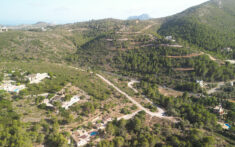The Pla de Petracos, located in the municipality of Castell de Castells, is one of the most outstanding examples of Macro-schematic Art in all of Europe. It is declared a Site of Cultural Interest and a World Heritage Site by UNESCO. The Pla de Petracos sanctuary is a common place to visit and one of the most important tourist centers in the interior of the province of Alicante.
Next you have an index with all the points that we are going to deal with.
- 1.
- 1.1.
- 2.
- 3.
How to get
The site takes its name from the game where it is located, Pla de Petracos. It is a set of eight shelters and a cave located on the left side of the Malafi Ravine. Its access is via a forest track that starts at kilometer 7 of the road from Benigembla to Castells de Castells, the CV-720. The site is located about 500 meters above sea level.
Ruta
When taking the forest track, we find Les Carrasques de Petracos, a group of large Aleppo pines. The track passes through crops such as almond, olive and carob trees, until it reaches a small group of houses. A little further on we will arrive at what remains of the hermitage of Petracos, devoured by nature. We continue along the path until we see a sign indicating the paintings: then we must take a path that goes up. At a crossroads there are more indications about the paintings, both the macroschematic and the
What to see
The Pla de Petracos is one of the best sites with rock art in the Valencian Community. At the time when the paintings were made, it was a sanctuary: a place where fertility or the agricultural cycle was worshiped. There are various elements of dissemination, such as explanatory panels, as well as elements of protection protection (fences to avoid getting too close to the paintings) and access to the complex.
History
The set of paintings was discovered in 1980 and dates to around 8000 years ago. It is made up of eight coats, of which five have very striking figures painted in an intense red. Of these five shelters, four conserve representations framed as Macroesquematic Art. The other coat has part of a representation of Levantine Art, later than those of Macroesquematic Art, which are from the Neolithic.
Above all, human figures are represented, such as those praying, with their hands raised towards the sky. They are representations of the life and religion of the first farmers who populated these lands. There are also serpentine geometric motifs.
In the Pla de Petracos there was also an old Moorish town. In fact, one of the most important battles between Moors and Christians took place there, after the expulsion decree of 1609.






